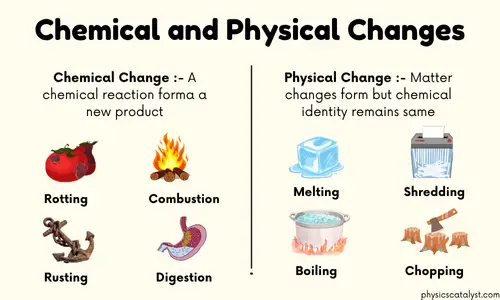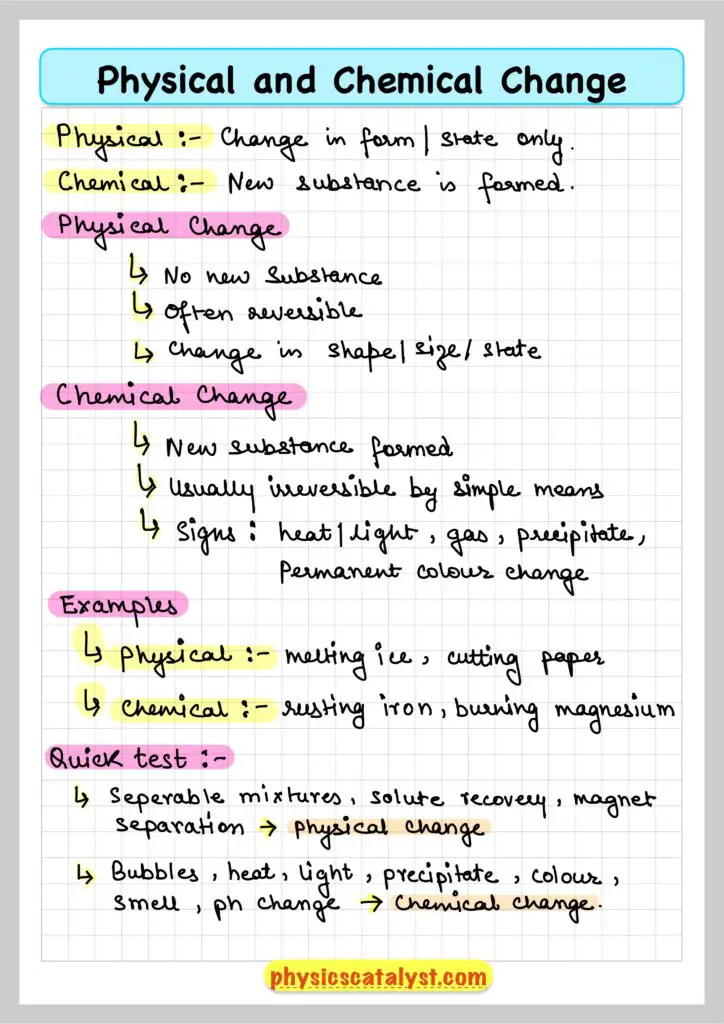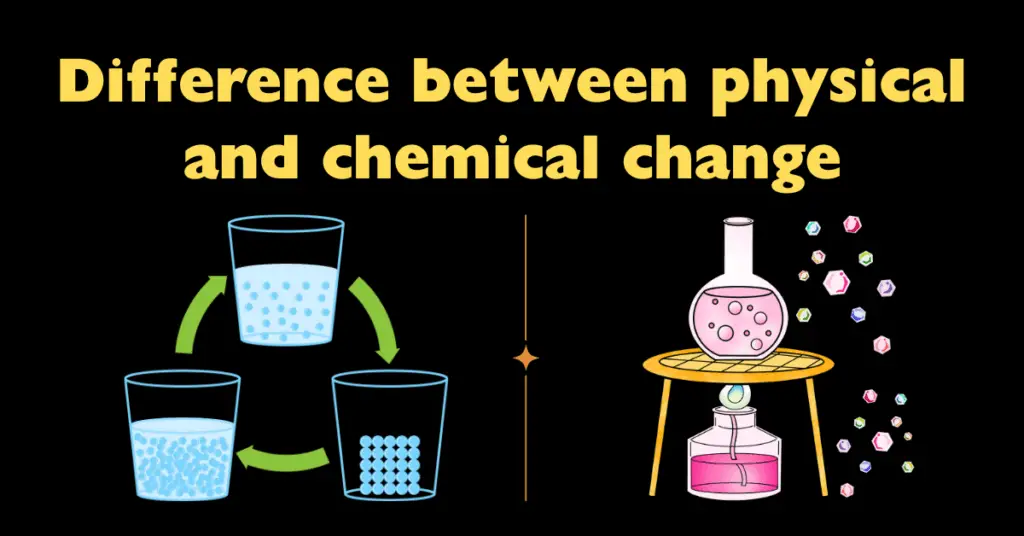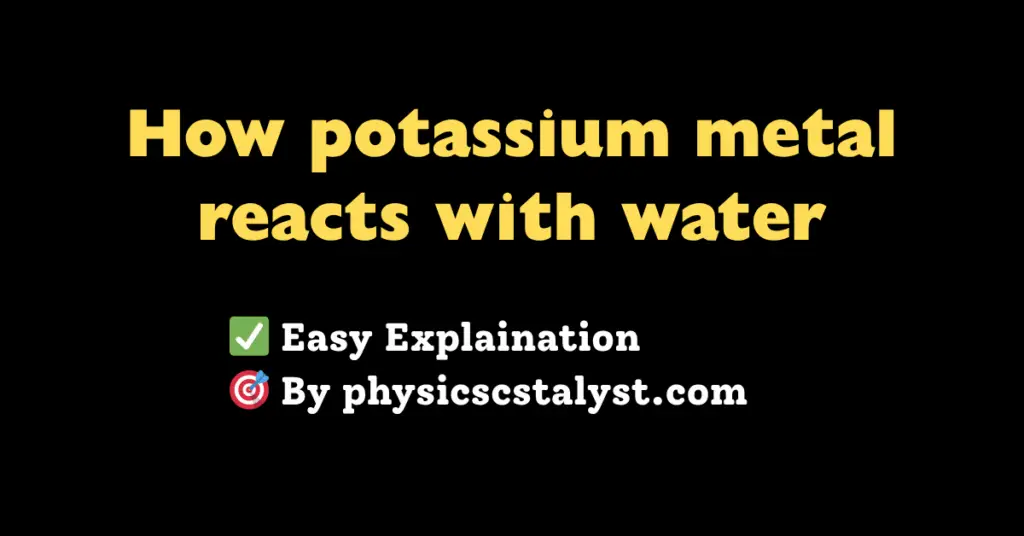Physical change alters only the form, size, or state of a substance without forming a new substance, whereas chemical change produces one or more new substances with different properties.
This article is suitable for students in Classes 7–10. It explains the difference between physical and chemical change with clear definitions, tests, and everyday examples, making it ideal for class notes and exam revision. Teachers can use the quick checklist and revision table for rapid recap.
Key definitions
- Physical change: A change in shape, size, or state in which the composition of the substance remains the same. Usually reversible by simple physical processes.
- Chemical change (chemical reaction): A change in which one or more new substances are formed with properties different from the original substances. Often difficult to reverse by simple physical means.
Particle view (what happens to particles)
- Physical change: Particles of the substance remain the same; only their arrangement, spacing, or motion changes (e.g., solid to liquid).
- Chemical change: Atoms rearrange and new bonds form while old bonds break, creating new substances. Energy is absorbed or released due to bond changes.
How to identify the type of change
- Look for a new substance: New colour (not just due to mixing a dye), new smell, new taste, or new chemical properties indicate a chemical change.
- Gas evolution: Bubbles without heating/boiling usually indicate a chemical change.
- Precipitate formation: A solid forming in a solution shows a chemical change.
- Energy change: Noticeable heat, light, or sound often accompanies chemical changes. Small heating/cooling can also accompany physical changes (e.g., melting).
- Reversibility: Physical changes are often reversible by simple methods (melting–freezing, evaporation–condensation). Chemical changes are generally hard to reverse by physical methods.
- Caution: Colour change, irreversibility, or gas formation alone are not perfect tests. For example, boiling water makes steam (gas) but is a physical change.
Everyday examples with reasoning

- Melting ice, freezing water, boiling water: Physical change; state changes but water remains water.
- Dissolving salt or sugar in water: Physical change; no new substance; solute can be recovered by evaporation/crystallization.
- Cutting paper, breaking chalk: Physical change; size changes, composition does not.
- Stretching a rubber band, hammering metal into a sheet: Physical change; shape changes.
- Burning a candle: Both changes occur. Melting of wax near the flame is physical; burning of wax (forming carbon dioxide and water) and burning of wick are chemical.
- Rusting of iron: Chemical change; iron reacts with oxygen and moisture to form rust (iron oxides) with different properties.
- Cooking food, curdling of milk, ripening of fruits: Chemical changes; new substances and flavors form.
- Vinegar and baking soda: Chemical change; carbon dioxide gas evolves, new substances form.
- Magnesium ribbon burning: Chemical change; bright light, heat, and formation of magnesium oxide (new substance).
Simple class activities
- Iron and sulfur mixture vs compound:
- Mix iron filings and sulfur: Physical change; separate iron with a magnet.
- Heat the mixture to form iron sulfide: Chemical change; cannot be separated by a magnet; new substance forms.
- Vinegar + baking soda: Observe gas evolution (CO2) and extinguishing of a glowing splint.
- Copper sulfate solution + iron nail: Colour changes and a reddish-brown deposit of copper on the nail (chemical change).
- Ice–water–steam cycle: Demonstrate reversible physical changes by changing temperature.
Common misconceptions
- “All irreversible changes are chemical.” Not always. Breaking a glass is practically irreversible but is a physical change.
- “Any colour change means chemical change.” Adding a dye or mixing paints is a physical change; color change due to reaction (e.g., rusting) is chemical.
- “Any gas formation means chemical change.” Gas from boiling water is physical; gas from vinegar + baking soda is chemical.
- “Dissolving always makes a new substance.” Dissolving is usually a physical process; the solute can be recovered unchanged.
Why the distinction matters
- Predicting whether original materials can be recovered.
- Choosing suitable methods for separation (physical methods vs chemical reactions).
- Understanding energy changes in processes (industrial and everyday).
Quick checklist (decision aid)
- Is a new substance formed with different properties? If yes ? chemical change.
- Are only state, size, or shape changing? If yes ? physical change.
- Are bubbles produced without boiling, or is a precipitate formed? Likely chemical.
- Is the change easily reversible by heating/cooling/pressure? Likely physical.
- Is there a significant heat/light effect with new substances? Likely chemical.
Revision table for difference between physical and chemical change
| Feature | Physical change | Chemical change | Examples |
|---|---|---|---|
| New substance formed | No | Yes | Physical: melting ice. Chemical: rusting iron. |
| Change in composition | No | Yes | Physical: dissolving salt (recoverable). Chemical: vinegar + baking soda. |
| Reversibility | Often easily reversible | Usually difficult to reverse by physical means | Physical: freezing–melting. Chemical: curdling milk. |
| Energy effect | Small changes; mainly due to state changes | Often large; heat/light may be released or absorbed | Physical: boiling water. Chemical: burning magnesium. |
| Particle-level change | Particles unchanged; arrangement/spacing changes | Atoms rearrange; bonds break/form | Physical: stretching rubber. Chemical: digestion of food. |
| Observable clues | Change in state, size, shape; no new smell/precipitate | New color/smell, gas evolution (without boiling), precipitate | Physical: cutting paper. Chemical: formation of a solid in solution. |
| Separation/recovery | Original substance recoverable by physical methods | Requires another chemical reaction to reverse (if possible) | Physical: evaporate salt solution. Chemical: decomposing rust is not simple. |
Concise summary


